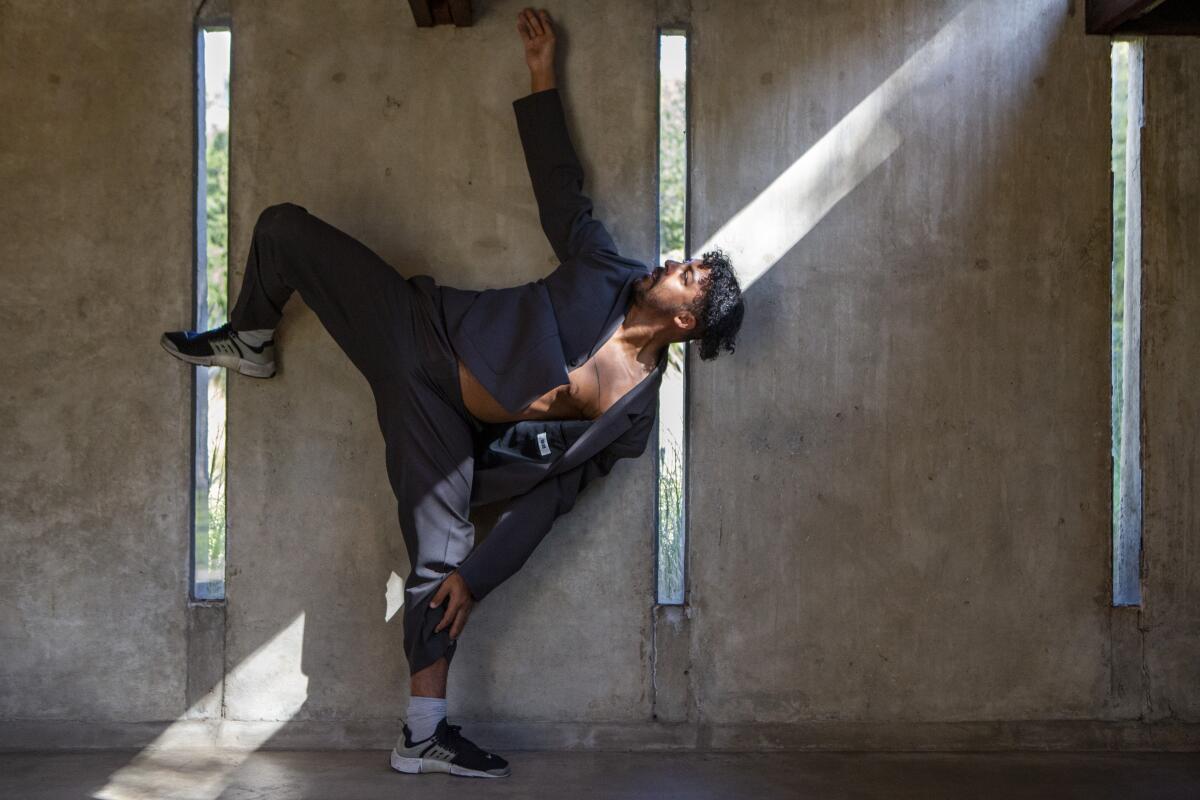Essential Arts: We have a plan! LACMA’s gallery plans, that is ...

- Share via
The iconic Ruth Bader Ginsburg has left us, a figure who fought for the rights of women and became a highly unlikely celebrity in the process. (The Skirball had a whole show devoted to her life in 2018.) I’m Carolina A. Miranda, staff writer at the Los Angeles Times, and I’m pouring one out for Notorious RBG. I’m also here with the week’s essential arts news:
On the media
It was with a heart full of bummer that I read about buyouts, followed by layoffs at KCRW this week — all of which means that in two short days, the station lost 18% of its staff. As a regular talking head at the station, one I have long valued for its dedication to cultural stories, it was painful to see. Among the folks announcing they have taken buyouts was Frances Anderton, host of the weekly podcast Design and Architecture, whose program I have appeared on in the past. She departs in December.
All of this comes on the heels of the shutdown of the urban development and real estate website Curbed LA in June. At that time, the site shed most of its staff and now operates under the national umbrella of Curbed.com. That site is in the process of being folded in as a vertical under New York magazine (both outlets are owned by Vox Media).
None of this is good news for design, urbanism and architecture coverage in Southern California. Curbed LA was the cheeky chaser of NIMBYS and Hollywood’s Target husk. It also assiduously covered proposed building projects and urban policy. Its move to New York magazine also raises the specter of journalism about L.A. that is less for Angelenos than for New York-y types who think no one in our city walks or eats bread.
Make the most of L.A.
Get our guide to events and happenings in the SoCal arts scene. In your inbox every Monday and Friday morning.
You may occasionally receive promotional content from the Los Angeles Times.
Anderton’s contributions were also critical. On her show, she did essential reporting on gun design, cannabis dispensary aesthetics and important film houses, as well as a critical series, titled Home in L.A., that examined issues of housing and its design in our evolving city. Without her program, there will be fewer stories about design in all of its forms. That is not good for architecture — and it’s not good for L.A.
Anderton tells me that even though she’s leaving KCRW, that doesn’t mean she has any intention of “staying quiet about L.A. design/architecture/urbanism.” If we’re lucky, maybe she can host some radio specials as a freelancer? Whatever happens, let’s just hope she doesn’t run off to start her “fantasy goat farm” even though I would totally be into the cheese.
Now, onto the news ...
LACMA
Queue Etta James — because aaaaat laaaaaast we are seeing a floor plan and some internal gallery renderings for LACMA’s taxpayer-funded museum, designed by Swiss architect Peter Zumthor. The topline from my report: The new building’s entire elevated floor will be galleries (about 110,000 square feet) — clusters of boxy exhibition spaces surrounded by transitional areas that can also be used to display work under different lighting conditions.
If the renderings are any indication, the rooms look all kinds of gray. Like the gray of a freshly flipped house. Or the gray of an English coal-mining town during the Thatcher era. In other words, rilly rilly gray. This is due to the combination of black floors (which may be fabricated out of an asphalt terrazzo) and poured-in-place concrete walls. But, again, these are renderings — which may or may not bear any connection to reality. Though, separately, I do have concerns about how these very hard surfaces will play out physically and acoustically on such a massive scale.
One of the new building’s goals, says LACMA director Michael Govan, is to produce a museum that is “nonhierarchical” and doesn’t privilege one form of art over another. To that point, New York Times art critic Jason Farago posted a link to some interesting reading by writer and curator Roger M. Buergel about architect Lina Bo Bardi’s Museo de Arte de Sao Paulo, which Farago says offers a good model for “dehierarchized museum displays.”
Writes Buergel: “Attempting to epitomise the gold standard of legitimate knowledge in a world of crumbling canons is ridiculous. Attempting to epitomise contemporary sexiness is worse. A methodology is needed that addresses audiences as neither consumers nor infants, but as partners.”
Enjoying this newsletter? Consider subscribing to the Los Angeles Times
Your support helps us deliver the news that matters most. Become a subscriber.
Speaking of partners, urbanism writer Alissa Walker looks at how the design process for this public museum has occurred with virtually no input from the actual public.
Culture writer Deborah Vankin, along with photographer Robert Gauthier, check out the ongoing demolition of LACMA’s old buildings.
Since we’re on the subject of LACMA: Board member Tom Gores is under fire for his investment in a prison phone company. Two groups have a sent a letter to Govan and the board’s co-chairs demanding that Gores be removed from the board, writing that the billionaire profits from the “deliberate exploitation of Black, Brown, and economically distressed communities.”
Coronavirus and the arts
With museums in Los Angeles County still closed, Times art critic Christopher Knight has been watching TV: the 10th season of PBS’ Art21, to be exact, which over the course of its hourlong programs examines the artistic process. As he notes, it’s a show with “no curators, no critics, no collectors,” just a focus on the ways in which artists work in their studios.
Classical music critic Mark Swed continues to hit the headphones. This week, he’s onto Mozart’s Sinfonia Concertante, which he describes as an unprecedented work. “Double and triple concertos tended to be celebratory and gimmicky,” he writes. But the Sinfonia “announces its ambitions from the start” with its opening “viola-infused chord” and “a flowering of melodies, one idea flowing from another, with as much irrepressible logic as invention.”
Music writer Randall Roberts reports on the Broad museum’s new film series, “L.A. Intersections: Music, Language, Movement,” featuring a series of performances by more than a dozen L.A. artists. The first episode landed this week and features dance by Mike Tyus, poetry by Shonda Buchanan, and music from San Cha and Mx. Matías, as well as serpentwithfeet.
The films are a pandemic-safe way for the museum to mark its fifth anniversary, says the Broad’s Ed Patuto. And I dig the format. Sooo much better than a blabby Zoom panel! And it’s worth highlighting that San Cha crooning “Malagueña” will give you goosebumps.
Theater critic Charles McNulty has girded himself for a short-term future of digital theatrical offerings. His advice to theater companies: keep these productions special with appointment viewing. He also puts together a wish list of online productions he would like to see, including a play by Jeremy O. Harris for Jane Fonda, a musical about the apocalypse starring Young Jean Lee and a Zoom play by Pulitzer-winning Jackie Sibblies Drury.
Related: McNulty reviews Richard Nelson’s “Incidental Moments of the Day,” the final play in the playwright’s pandemic trilogy, which has held a mirror up to the “white, progressive, culturally engaged class that is drinking considerably more wine to cope with the isolation and disorientation of the pandemic.”
In March, choreographer Chris Emile opened “Amend” at the MAK Center for Art and Architecture, a show that explored Black masculinity through dance. Because of the pandemic, it closed after a week. The Times’ Makeda Easter reports that the show is back (albeit with COVID-19 guidelines in place) and that its content has been energized by the uprisings. “To have this new context of white people finally admitting that there is racism,” says Emile, “there’s a new level of the performers tapping into what that feels like as a Black man now.”

Contributing reviewer Leah Ollman is back in the galleries, checking out installations by Ricky Swallow and Doyle Lane at David Kordansky, a show “assembled with deliberate casualness” by Kaz Oshiro at Nonaka-Hill, a trio of artists at Steve Turner Gallery that included work by Rebecca Brodskis, David Shrobe and Kevin McName-Tweed, and a poignant show about breath by Susan Philipsz at Tanya Bonakdar.
Sharon Mizota has been looking at the world through her phone — specifically a film by Marco Brambilia on the augmented reality app Acute Art. The piece, which features Cate Blanchett, turns the film star into the “four temperaments” of Greek philosophy.
Laura Zornosa reports on Ballet Folklórico’s drive-in performance organized by the Muckenthaler Cultural Center in Fullerton, and Nikki Munoz looks at how the Independent Shakespeare Co.‘s free summer festival is migrating to the web.
I spent time in a co-working space that has managed to remain open despite the pandemic. That’s because Second Home in Hollywood — which is housed in a Paul R. Williams building that has been redone by Spanish firm Selgascano — has among its offerings 60 individually ventilated pods in an open-air garden.
Sell-off
The Everson Museum of Art in Syracuse announced it will auction off Jackson Pollock’s “Red Composition,” from 1946, a work that has been in its collection for almost 30 years. The museum has stated that the sale is intended to fund more diverse acquisitions. Christopher Knight isn’t buying. He writes that if the Everson were truly serious about diversity, it would commit “in writing, in its by-laws and through action — to a thorough structural overhaul that would bring actual equity to its boardroom, staff and volunteer rosters, as well as its exhibition program and purchases of art.”
In an unrelated story on NPR about diversifying museum collections, Emma Jacobs has a good quote from curator Valerie Cassel Oliver, of the Virginia Museum of Fine Arts, on the matter of using a high-profile (dare I say performative?) sale to fund other acquisitions: “I think that sets up binaries that I think feed into this notion or this anxiety and this fear that in order to represent other people, you have to erase or remove others. And that’s a fallacy.” What museums should do instead, she says, is make it a priority to raise funds to buy more work by women and artists for color.
Passages
Terence Conran, the British designer and retailer who helped modernize the lives of everyday people with affordable furnishings, has died at 88 at his home in England.

In other news
— The always amazing Center for the Study of Political Graphics is fighting to stay in its Culver City space.
— “Like zombies, these highway projects continue to rear their ugly heads over and over.” Joe Linton over at Streetsblog has a good piece on the spiraling costs and eternal widening of the 5 Freeway.
— The reveals of LACMA’s gallery plans were important, but what’s more important is the Harry Potter-meets-Fred Flintstone apartment building that just opened in Berkeley. Critic John King has the goods.
— Art critic Peter Schjeldahl has a strong review of Janis A. Tomlinson’s new biography of Francisco Goya that examines how this masterful painter survived so many kingly regimes.
— Heidi Schreck’s “What the Constitution Means to Me” will land on Amazon Prime Oct. 16.
— L.A.-based playwright Michael John Garcés and choreographer Ana Maria Alvarez have been named Doris Duke Artists for 2020, an honor that comes with a $275,000 prize.
— I didn’t know I needed Alexander Nazaryan’s rage-filled review of Bob Woodward’s “Rage” but I did. I really, really did.
And last but not least ...
Several weeks ago, Mark Swed wrote that Bach’s Cantata No. 82 has a “lullaby of consoling sweetness” at its heart. And since right now we could all use some consoling, here is Sir John Eliot Gardiner performing the cantata.
The biggest entertainment stories
Get our big stories about Hollywood, film, television, music, arts, culture and more right in your inbox as soon as they publish.
You may occasionally receive promotional content from the Los Angeles Times.




